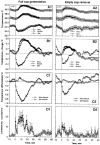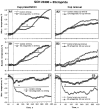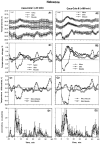Differential effects of dopamine and opioid receptor blockade on motivated Coca-Cola drinking behavior and associated changes in brain, skin and muscle temperatures
- PMID: 20167257
- PMCID: PMC2849912
- DOI: 10.1016/j.neuroscience.2010.02.032
Differential effects of dopamine and opioid receptor blockade on motivated Coca-Cola drinking behavior and associated changes in brain, skin and muscle temperatures
Abstract
Although pharmacological blockade of both dopamine (DA) and opiate receptors has an inhibiting effect on appetitive motivated behaviors, it is still unclear which physiological mechanisms affected by these treatments underlie the behavioral deficit. To clarify this issue, we examined how pharmacological blockade of either DA (SCH23390+eticlopride at 0.2 mg/kg each) or opioid receptors (naloxone 1 mg/kg) affects motor activity and temperature fluctuations in the nucleus accumbens (NAcc), temporal muscle, and facial skin associated with motivated Coca-Cola drinking behavior in rats. In drug-free conditions, presentation of a cup containing 5 ml of Coca-Cola induced locomotor activation and rapid NAcc temperature increases, which both transiently decreased during drinking, and phasically increased again after the cup was emptied. Muscle temperatures followed this pattern, but increases were weaker and more delayed than those in the NAcc. Skin temperature rapidly dropped after cup presentation, remained at low levels during consumption, and slowly restored during post-consumption behavioral activation. By itself, DA receptor blockade induced robust decrease in spontaneous locomotion, moderate increases in brain and muscle temperatures, and a relative increase in skin temperatures, suggesting metabolic activation coupled with adynamia. Following this treatment (approximately 180 min), motor activation to cup presentation and Coca-Cola consumption were absent, but rats showed NAcc and muscle temperature increases following cup presentation comparable to control. Therefore, DA receptor blockade does not affect significantly central and peripheral autonomic responses to appetitive stimuli, but eliminates their behavior-activating effects, thus disrupting appetitive behavior and blocking consumption. Naloxone alone slightly decreased brain and muscle temperatures and increased skin temperatures, pointing at the enhanced heat loss and possible minor inhibition of basal metabolic activity. This treatment (approximately 60 min) had minimal effects on the latencies of drinking, but increased its total duration, with licking interrupted by pauses and retreats. This behavioral attenuation was coupled with weaker than in control locomotor activation and diminished temperature fluctuations in each recording location. Therefore, attenuation of normal behavioral and physiological responses to appetitive stimuli appears to underlie modest inhibiting effects of opiate receptor blockade on motivated behavior and consumption.
(c) 2010 IBRO. Published by Elsevier Ltd. All rights reserved.
Figures







Similar articles
-
Phasic and tonic fluctuations in brain, muscle, and skin temperatures during motivated drinking behavior in rats: physiological correlates of motivation and reward.Brain Res. 2010 Jan 15;1310:87-102. doi: 10.1016/j.brainres.2009.11.036. Epub 2009 Nov 22. Brain Res. 2010. PMID: 19932691 Free PMC article.
-
Brain temperature responses to salient stimuli persist during dopamine receptor blockade despite a blockade of locomotor responses.Pharmacol Biochem Behav. 2008 Dec;91(2):233-42. doi: 10.1016/j.pbb.2008.08.004. Epub 2008 Aug 8. Pharmacol Biochem Behav. 2008. PMID: 18727935 Free PMC article.
-
Dopamine-dependent and dopamine-independent actions of cocaine as revealed by brain thermorecording in freely moving rats.Eur J Neurosci. 2005 Aug;22(4):930-8. doi: 10.1111/j.1460-9568.2005.04269.x. Eur J Neurosci. 2005. PMID: 16115216
-
Motivational views of reinforcement: implications for understanding the behavioral functions of nucleus accumbens dopamine.Behav Brain Res. 2002 Dec 2;137(1-2):3-25. doi: 10.1016/s0166-4328(02)00282-6. Behav Brain Res. 2002. PMID: 12445713 Review.
-
The role of nucleus accumbens dopamine in motivated behavior: a unifying interpretation with special reference to reward-seeking.Brain Res Brain Res Rev. 1999 Dec;31(1):6-41. doi: 10.1016/s0165-0173(99)00023-5. Brain Res Brain Res Rev. 1999. PMID: 10611493 Review.
References
-
- Agmo A, Galvan A, Talamantes B. Reward and reinforcement produced by drinking sucrose: two processes that may depend on different neurotransmitters. Pharmacol Biochem Behav. 1995;52:403–414. - PubMed
-
- Altschule MD. Emotion and circulation. Circulation. 1951;3:444–454. - PubMed
-
- Arbisi PA, Billington CJ, Levine AS. The effect of naltrexone on taste detection and recognition threshold. Appetite. 1999;32:241–249. - PubMed
-
- Baker M, Cronin M, Mountjoy D. Variability of skin temperature in the waking monkey. Am J Physiol. 1976;230:449–455. - PubMed
-
- Barbano MF, Cador M. Differential regulation of the consummatory, motivational and anticipatory aspects of feeding behavior by dopaminergic and opioidergic drugs. Neuropsychopharmacology. 2006;31:1371–1381. - PubMed
Publication types
MeSH terms
Substances
Grants and funding
LinkOut - more resources
Full Text Sources

